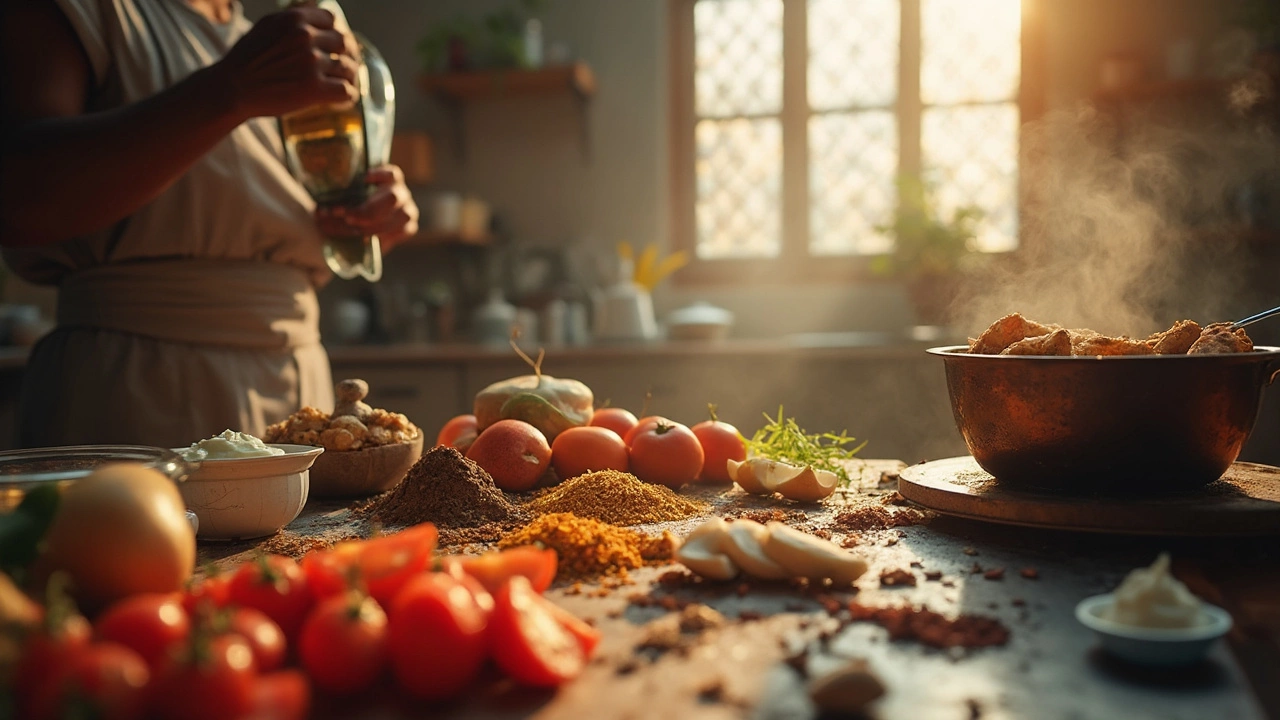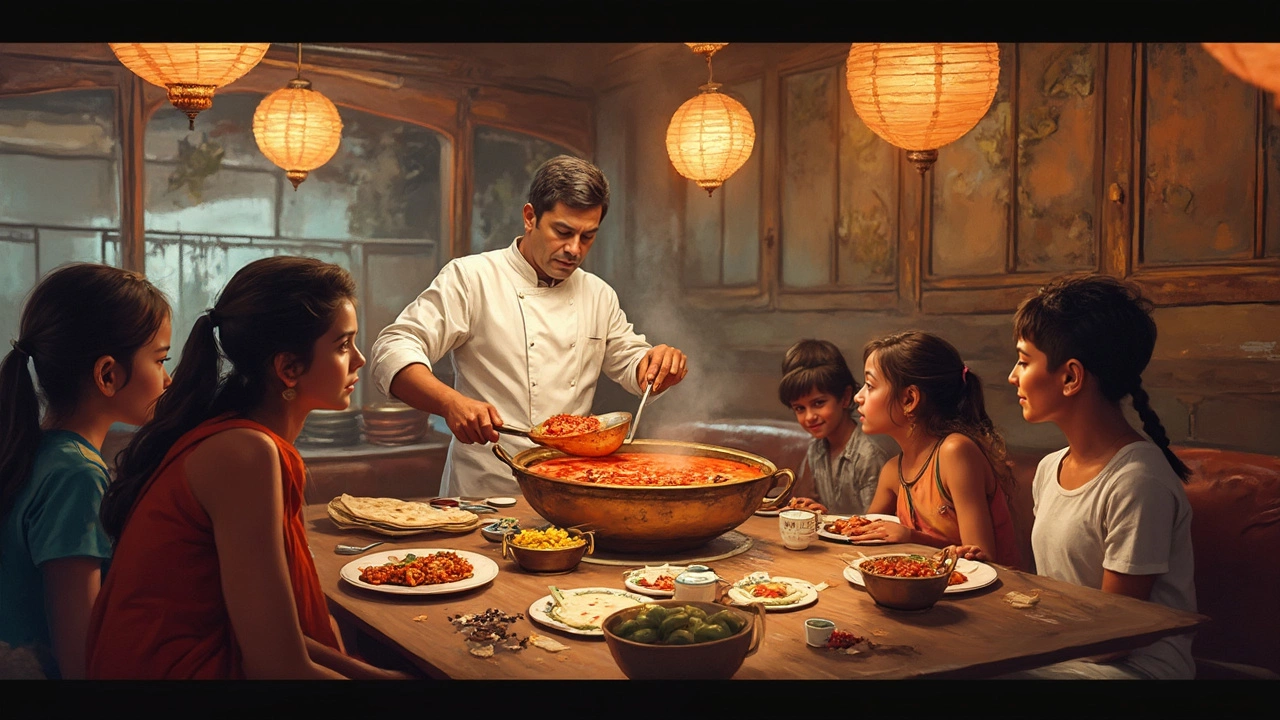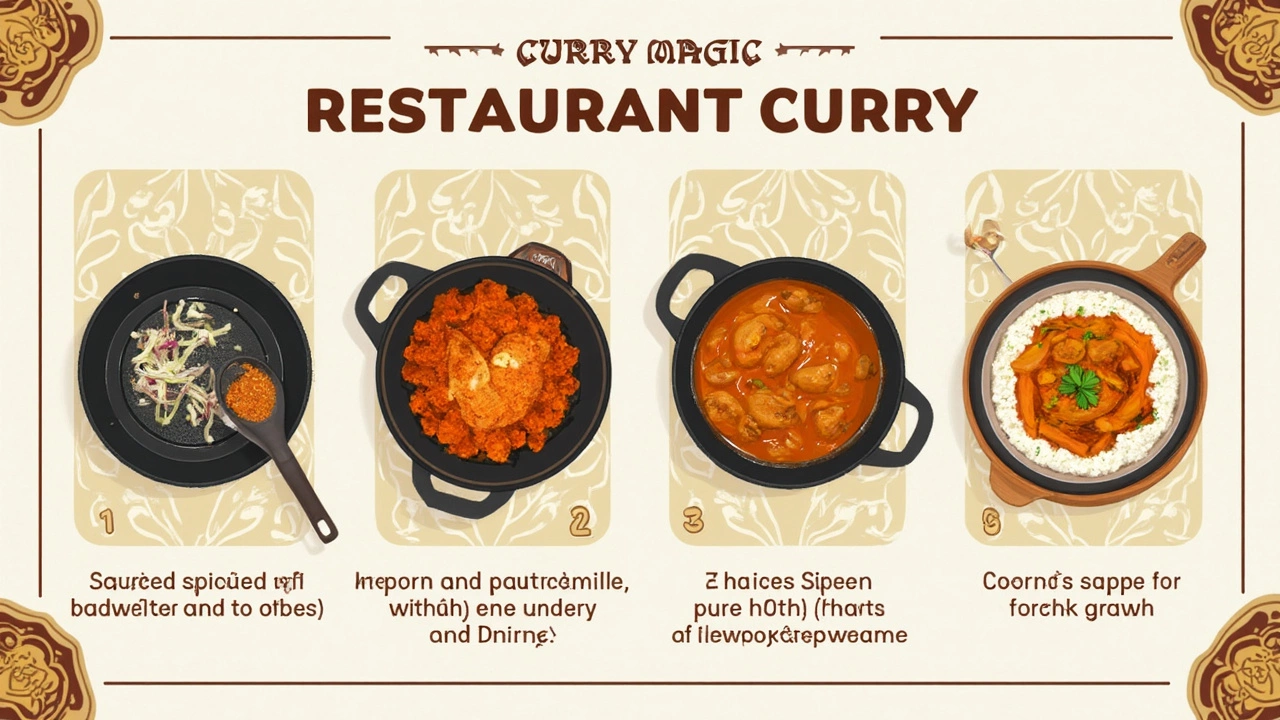How Indian Restaurants Make Curry So Thick: The Secrets Behind Perfect Chicken Curry
 Apr, 25 2025
Apr, 25 2025
Ever sat at a restaurant, digging into chicken curry, and wondered, “How do they get this so thick and creamy every single time?” Your homemade version ends up runny, or just doesn’t have that same clingy sauce. It’s not magic, it’s all about technique and a few chef tricks you probably haven’t tried yet.
Restaurant kitchens use some clever shortcuts, but thick curry starts with smart ingredient choices. Tomato puree (not just chopped tomatoes), heaps of onions, and a good bit of fat make the base smoother and richer. The way they cook these down—sometimes for longer than you’d expect—creates a deeply flavored, almost jammy masala that gives restaurant curries their body.
- The Core Ingredients Behind Restaurant-Style Curry
- Technique: The Art of the Bhunao
- Secret Thickeners You Didn't Know
- Restaurant Cooking Equipment vs. Home Kitchens
- How to Thicken Chicken Curry at Home
The Core Ingredients Behind Restaurant-Style Curry
There’s no way around it: the stuff you put in defines how thick and tasty your thick curry turns out. Restaurants use certain ingredients every single time, and they don’t skimp where it matters. If you want to crack this code at home, pay special attention to the main players that make a chicken curry recipe restaurant-worthy.
- Onions: No ingredient bulks up curry gravy better. Cooks in Indian restaurants usually chop or even blend loads of onions for that base. Slow-cooked onions turn sweet, break down, and help thicken everything up.
- Tomatoes: Not just the fresh kind—most restaurants reach for tomato puree (sometimes even canned or packaged) for a thick, consistent texture. It mixes better and gives you that rich, red color too.
- Cashew or almond paste: Want that creamy, restaurant-style gravy? Nut pastes are the secret weapon. They melt into the sauce and make it extra luscious, especially in North Indian curries.
- Yogurt and cream: Using full-fat yogurt or a splash of cream transforms the sauce. It’s what creates that silky finish and helps the sauce hold together instead of splitting.
- Ghee or oil: Don’t go shy with the fat. Fat acts as a carrier for all the masala, helps fry the onions and spices properly, and is key for that “glossy restaurant shine.”
If you want some kitchen math, check out how much of these common ingredients go in full-scale restaurant batches:
| Ingredient | For 1kg Chicken (Restaurant Style) |
|---|---|
| Onions | 250-300g (raw, chopped) |
| Tomato Puree | 150g |
| Cashew/Almond Paste | 40-60g |
| Full-fat Yogurt | 100g |
| Ghee/Oil | 75-100ml |
Notice those numbers? Home cooks usually go lighter, but the pros know that more of these building blocks means thicker, smoother, better Indian restaurant curry. It’s never just about the meat—the sauce is half the story. Start with these, and you’re already halfway to proper, stick-to-your-rice chicken curry.
Technique: The Art of the Bhunao
Here’s the move most folks miss when trying to get that perfect thick curry texture at home: the bhunao. This is a classic Indian cooking technique, and it’s the reason your favorite Indian restaurant curry tastes so much richer than a basic home attempt.
So what is bhunao? It’s all about cooking your onions, ginger, garlic, and spice mixture down slowly over medium heat. The masala goes from watery and raw-smelling to thick, oily, and deeply browned. This isn’t a quick stir—the process can take anywhere from 15 to 30 minutes, depending on the quantity you’re making. The slow cook lets the water evaporate, the sugars in the onions caramelize, and the oil to separate out from the masala (that’s your signal you’re done!).
Here’s how restaurants do it:
- They slice or chop onions super fine—sometimes even blend them for smoother texture.
- Onions go into hot oil and are sautéed until golden brown, not just soft.
- Tomato puree and spices go in next, and everything gets cooked (and stirred often!) until the whole mixture is thick and the oil floats to the top.
- This cooked-down masala is now the flavor and texture bomb that makes chicken curry recipe stand out.
You’ll notice chefs are patient—rushing this step leaves you with a watery or grainy curry, not one that coats a spoon. A good bhunao is why curries in Indian restaurants almost never separate into watery and oily layers like they sometimes do at home.
If you’re looking to nail that restaurant look, use plenty of onions (about 2 to 3 times more than you’d expect), always cook on medium-low, and don’t skip the stirring.
| Ingredient | Typical Quantity (for 4 servings) |
|---|---|
| Onions (chopped/blended) | 2 to 3 large |
| Oil or ghee | 1/4 to 1/3 cup |
| Tomato puree | 1 cup |
| Spices | 2-3 tablespoons |
Master the bhunao, and you’re halfway to a restaurant-style, thick curry every single time.

Secret Thickeners You Didn't Know
If you think thick curry is all about heavy cream, think again. Indian chefs use unexpected tricks to get that perfect, clingy texture in their restaurant chicken curry recipe. And most of these are probably sitting in your own kitchen right now.
The big one is ground nuts, especially cashews or almonds. Once blended into a smooth paste, they melt right into the curry, making it rich but not heavy. A chef I know swears by cashew paste. He says,
"Just a tablespoon blended with water is enough to give curry that restaurant touch—no one even guesses it’s nuts and not cream."
Ready for another? Roasted gram flour (besan) is a secret weapon you rarely hear about. Chefs lightly toast a spoonful and stir it into the onion-tomato mix. It disappears into the sauce but thickens everything up without a weird taste. Not just that, some places use a bit of boiled, mashed potato—it dissolves and thickens just like a pro, especially when you want a vegan option.
- Cream: Adds richness but can dull spices if you use a lot. Go easy.
- Yogurt: Thickens and adds tang, but always stabilize it with a bit of flour to stop curdling.
- Cornstarch: Western hack that some restaurants use, especially in creamy or fusion curries.
- Ground poppy seeds: Classic in Mughlai dishes. You soak, grind, and toss them in for a smooth, thick finish.
Restaurants don’t just rely on one thing. They often layer two or three of these for texture and depth, not just thickness. Here’s a quick look at which thickeners get used most often, just from a survey of five popular Indian restaurants in Mumbai:
| Thickener | Percentage Using |
|---|---|
| Cashew Paste | 80% |
| Besan (Gram Flour) | 60% |
| Cream | 50% |
| Yogurt | 30% |
| Cornstarch | 10% |
If your thick curry has ever tasted spot-on at a restaurant—it’s thanks to these stealthy additives. Try one or combine two, and you’ll get that lush finish every time.
Restaurant Cooking Equipment vs. Home Kitchens
Ever wondered why that thick curry at your favorite spot tastes different from what you whip up at home? A big chunk of that comes down to the gear and setup in restaurant kitchens. Professional kitchens have the tools for serious batch cooking, which makes a huge difference when it comes to texture and flavor.
For starters, Indian restaurants use heavy-duty gas burners and super wide, deep pans—like kadais or industrial-sized pots—that let them cook big quantities at once. The direct, high heat helps brown onions faster, evaporate water quickly, and caramelize the base to bring out those sweet, savory flavors. This stuff is tough to replicate on a regular stovetop or with a non-stick pan at home.
- Restaurants usually have large, flat-bottomed pans that let them fry onions and tomatoes in a thin layer, speeding up browning and thickening.
- Their powerful burners mean more evaporation and more concentrated flavors in less time.
- Large utensils make it easy to sauté and stir without stuff sticking or burning, so they can bhunao (roast) the masala much better.
- Many use immersion blenders or spice grinders to get silky-smooth gravies—no chunky bits in sight.
Let’s compare how these two kitchens stack up when cooking your favorite chicken curry recipe:
| Aspect | Restaurant Kitchen | Home Kitchen |
|---|---|---|
| Heat source | Powerful gas burners | Standard gas/electric stoves |
| Pots/pans | Large, deep, flat-bottomed kadais | Regular non-stick or steel pans |
| Batch size | Big batches (1-5 liters at once!) | Small batches (1-2 liters max) |
| Blending | Heavy-duty immersion blenders | Small blenders or none |
All these upgrades mean a thick curry comes together faster and tastes richer in restaurants. While you can’t always swap your kitchen out for a pro one, you can still borrow a few tricks. Use a wide, heavy pan if you’ve got it, let that sauce bubble away uncovered, and don’t be afraid to invest in a basic hand blender for silky gravies. Even small tweaks can make your Indian restaurant curry dreams much closer to reality at home.

How to Thicken Chicken Curry at Home
You don’t need a fancy kitchen or pro-level skills to get your thick curry game on point at home. It’s all about using what you already have and tweaking a few steps. Here's how you can make your own Indian restaurant curry that has that perfect, rich, and clingy sauce:
- Bhunao the masala well: The biggest secret is patience. Cook down the onions, ginger, and garlic until they turn deep golden brown. This takes at least 12-15 minutes over medium heat. If you add tomatoes, cook those until the oil really separates out. That naturally thickens the base of your chicken curry recipe.
- Use ground nuts or seeds: Indian restaurants often blend in cashews, almonds, or even poppy seeds to thicken the gravy. You can blitz a handful of raw cashews with some water and stir it in after you’ve added all the spices and chicken.
- Tomato puree, not chopped tomatoes: Skip chunky tomatoes. Puree does two things—it thickens the sauce and merges flavors for that classic restaurant finish. Simmer until most of the water cooks off.
- Yogurt or cream (but don’t curdle): This adds body, especially near the end. To stop it from splitting, whisk well and let it come to room temp before you add it to the curry. Add a tablespoon of flour to the yogurt if you want extra insurance.
- Reduce, reduce, reduce: Let the curry bubble on a low flame, uncovered, until it thickens to your liking. Stir often—this alone makes a dramatic difference in texture.
If you’re ever in a pinch, you can add a tablespoon of besan (gram flour) or even mashed boiled potato for emergency thickening—but try the above tricks first for authentic results.
| Thickening Agent | Key Benefit | When to Add |
|---|---|---|
| Finely ground cashews | Rich, creamy body | After sautéing masala |
| Tomato puree | Smooth, tangy base | Early, with onions |
| Yogurt or cream | Silky finish | Near the end |
| Slow reduction | Concentrates flavor | Final stage |
Try a combo of these next time you cook up chicken curry. You’ll end up with a thick curry that rivals your favorite takeaway spot—no guessing, no watery sauce.